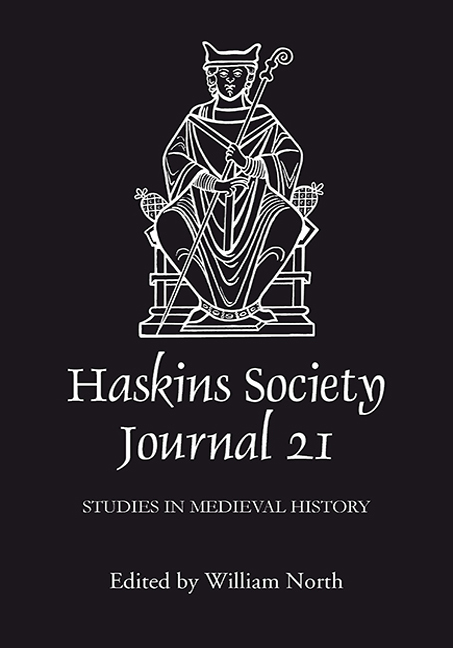Book contents
- Frontmatter
- Contents
- Editor's Note
- Abbreviations
- 1 Bede and the Rewriting of Sanctity
- 2 The Role of Rivers and Coastlines in Shaping Early English History
- 3 Containing Virginity: Sex and Society in Early Medieval England
- 4 Pagans and Infidels, Saracens and Sicilians: Identifying Muslims in the Eleventh-Century Chronicles of Norman Italy
- 5 Robert Curthose and the Norman Episcopate
- 6 The Revival of Roman Law: the Exceptiones Petri
- 7 Mutatis Mutandis: Literary Borrowing from Jerome's Letter to Eustochium and Others in the Life of Blessed Bernard of Tiron by Geoffrey Grossus
- 8 Acting Out Friendship: Signs and Gestures of Aristocratic Male Friendship in the Twelfth Century
- 9 The Quantification of Assarted Land in Mid- and Late Twelfth-Century England
- 10 Origins of Courtliness after 25 Years
3 - Containing Virginity: Sex and Society in Early Medieval England
Published online by Cambridge University Press: 28 April 2017
- Frontmatter
- Contents
- Editor's Note
- Abbreviations
- 1 Bede and the Rewriting of Sanctity
- 2 The Role of Rivers and Coastlines in Shaping Early English History
- 3 Containing Virginity: Sex and Society in Early Medieval England
- 4 Pagans and Infidels, Saracens and Sicilians: Identifying Muslims in the Eleventh-Century Chronicles of Norman Italy
- 5 Robert Curthose and the Norman Episcopate
- 6 The Revival of Roman Law: the Exceptiones Petri
- 7 Mutatis Mutandis: Literary Borrowing from Jerome's Letter to Eustochium and Others in the Life of Blessed Bernard of Tiron by Geoffrey Grossus
- 8 Acting Out Friendship: Signs and Gestures of Aristocratic Male Friendship in the Twelfth Century
- 9 The Quantification of Assarted Land in Mid- and Late Twelfth-Century England
- 10 Origins of Courtliness after 25 Years
Summary
Aldhelm of Malmesbury (639–710/1) is widely regarded as one of the leading scholars of the seventh century, and his treatise De Virginitate has increasingly been recognized as one of the most influential works in early medieval Northern Europe, second only perhaps to Bede's Historia Ecclesiastica. Increasing attention to this work over the past several years has rectified a long period of neglect for a man who had such an immense influence, and yet, the vast majority of modern historical consideration has focused almost exclusively on the literary influence of Aldhelm's style and form. Indeed, traditional readings of Aldhelm have tended to claim that he scarcely had any purpose at all in writing his most influential work, the De Virginitate, beyond showing off his prodigious Latinity. To be sure, Aldhelm's stylistic influence cannot be doubted. Andy Orchard recently suggested that ‘practically every Anglo-Latin hexameter composition penned within a century of his death is heavy with his influence; indeed much extant Latin metrical verse from Anglo-Saxon England written before the tenth century is little more than Aldhelmian pastiche’. Furthermore, the numerous surviving manuscripts of the De Virginitate and the later Carmen de Virginitate are heavily glossed, which speaks to both the difficulty of Aldhelm's text for later readers and the great interest in utilizing and understanding Aldhelm's work. Due to Aldhelm's highly distinctive style, scholarship directed towards tracking his influence on subsequent generations has proved extraordinarily successful. However, deciphering his content has proven much more difficult.
This article will address the content of Aldhelm's De Virginitate by examining its discourse concerning male and female sexuality and spiritual value, while locating it within its specific historical context. Following an analysis of the circumstances of the composition of the De Virginitate, this article will consider Aldhelm's interpretive strategies within the De Virginitate and his creative restructuring of the writings of Augustine, Jerome, Ambrose, and Cyprian, I will argue, which he crafted to create a workable authority for the double monastery. As the treatise was composed at a time of heightened concern for orthodoxy, it is no accident that Aldhelm's discourse relied on texts that bore an unmistakable imprimatur of Church authority. Aldhelm recast these works and their language concerning inner spirituality and exterior purity in a way that justified the authority and status of nuns in the double monastery.
- Type
- Chapter
- Information
- The Haskins Society Journal 212009. Studies in Medieval History, pp. 47 - 66Publisher: Boydell & BrewerPrint publication year: 2010



